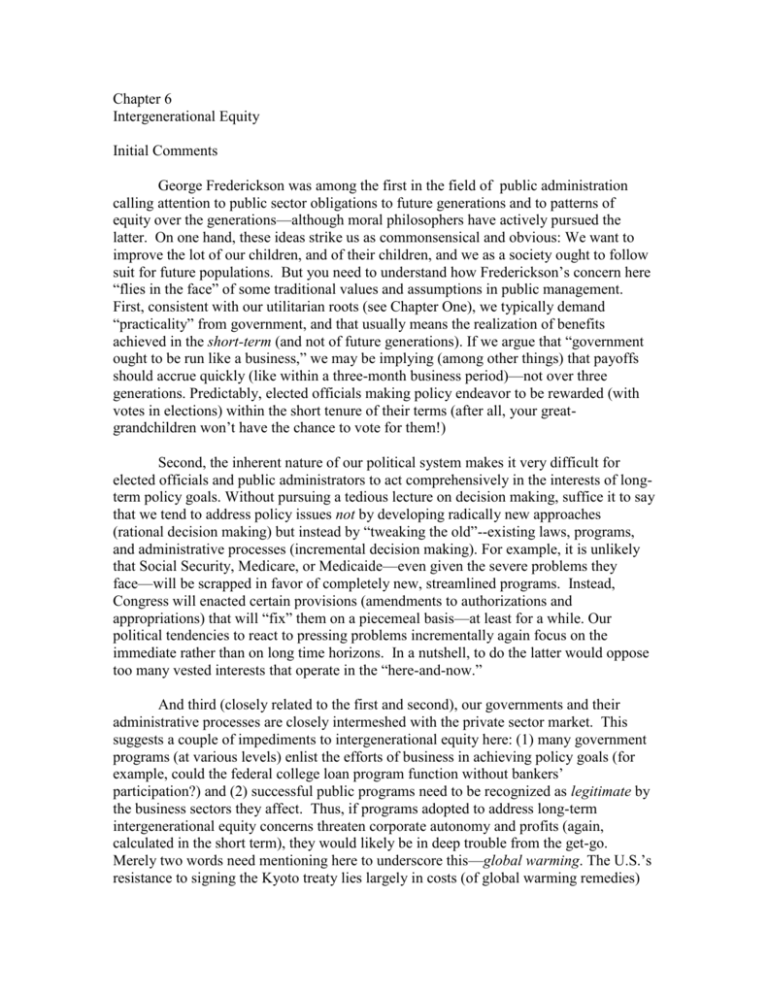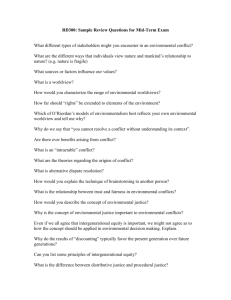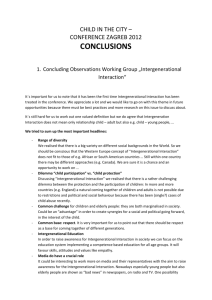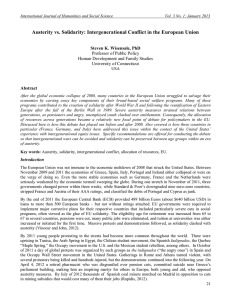Chapter 6
advertisement

Chapter 6 Intergenerational Equity Initial Comments George Frederickson was among the first in the field of public administration calling attention to public sector obligations to future generations and to patterns of equity over the generations—although moral philosophers have actively pursued the latter. On one hand, these ideas strike us as commonsensical and obvious: We want to improve the lot of our children, and of their children, and we as a society ought to follow suit for future populations. But you need to understand how Frederickson’s concern here “flies in the face” of some traditional values and assumptions in public management. First, consistent with our utilitarian roots (see Chapter One), we typically demand “practicality” from government, and that usually means the realization of benefits achieved in the short-term (and not of future generations). If we argue that “government ought to be run like a business,” we may be implying (among other things) that payoffs should accrue quickly (like within a three-month business period)—not over three generations. Predictably, elected officials making policy endeavor to be rewarded (with votes in elections) within the short tenure of their terms (after all, your greatgrandchildren won’t have the chance to vote for them!) Second, the inherent nature of our political system makes it very difficult for elected officials and public administrators to act comprehensively in the interests of longterm policy goals. Without pursuing a tedious lecture on decision making, suffice it to say that we tend to address policy issues not by developing radically new approaches (rational decision making) but instead by “tweaking the old”--existing laws, programs, and administrative processes (incremental decision making). For example, it is unlikely that Social Security, Medicare, or Medicaide—even given the severe problems they face—will be scrapped in favor of completely new, streamlined programs. Instead, Congress will enacted certain provisions (amendments to authorizations and appropriations) that will “fix” them on a piecemeal basis—at least for a while. Our political tendencies to react to pressing problems incrementally again focus on the immediate rather than on long time horizons. In a nutshell, to do the latter would oppose too many vested interests that operate in the “here-and-now.” And third (closely related to the first and second), our governments and their administrative processes are closely intermeshed with the private sector market. This suggests a couple of impediments to intergenerational equity here: (1) many government programs (at various levels) enlist the efforts of business in achieving policy goals (for example, could the federal college loan program function without bankers’ participation?) and (2) successful public programs need to be recognized as legitimate by the business sectors they affect. Thus, if programs adopted to address long-term intergenerational equity concerns threaten corporate autonomy and profits (again, calculated in the short term), they would likely be in deep trouble from the get-go. Merely two words need mentioning here to underscore this—global warming. The U.S.’s resistance to signing the Kyoto treaty lies largely in costs (of global warming remedies) that would be borne by the petroleum industry and U.S. economy. In short, it is not hard to show the short-term focus of the market as inhibiting long-term (and, at least in the short term, costly) policies to future-oriented policy issues. In response, “hard line” free market proponents might claim faith that “new technology out there”—waiting to be discovered and marketed—offers potential solutions for “curing”all of our long-term problems. So, in view of these obstacles, intergenerational equity could be alternatively approached as (a) a “nice” (but pie-in-the-sky) idea that is impractical and unrealistic or (b) a matter of extreme importance in a diverse society undergoing globalization. I suggest that the “smart money” is on (b) and Frederickson. Political language, interest alignments, and policy systems are taking on new shapes in a globally interdependent world. And some major corporations are recognizing the inadequacies of our current public sector policies and business strategies for sustainable development in the not-sodistant future. But the intergenerational implications of responses to the 2001 terrorist attacks are as sobering as unpredictable. On one hand, the effective curtailment of international terrorism would surely “make the world safer” for our progeny. But on the other, the accompanying deflection away from domestic concerns (such as education and the environment) may prove very costly to our nation in the long term. In the second section of Chapter Six, Frederickson applies the compound theory of social equity as a basis for assessing patterns of intergenerational (in)equity for public sector activities and issues. In so doing, his tables offer a convenient but meaningful way to assess costs and benefits over various intergenerational time frames. Given the unique natures of Hawaiian geography and culture, it is especially intriguing to probe an issue affecting the Islands—the Hawaiian native sovereignty movement—from the standpoint of intergenerational equity. Thus, some background on this issue is linked to the chapter in lieu of a case study. (You should seek out additional information should you pursue related portfolio items below.) Native sovereignty issues raise some tangential questions beyond chapter coverage, such as the nature of leadership skills required and of the significance (if any) of historical injustices to a generally future-oriented concern for intergenerational equity. Objectives 1. to understand the general concept of intergenerational equity, how it can be “outof-step” with traditional public management concerns, and how it involves public sector leadership. 2. to apply the compound theory of social equity to discern patterns of intergenerational equity. Key Questions 1. Can our society afford intergenerational equity? Be specific. 2. Some argue that leadership implies something different or more than management. Discuss this with regard to a public administrator’s challenge to foster intergenerational equity. 3. Intergenerational equity is often meant to imply an obligation to future generations. Do efforts aimed at rectifying historical injustices facilitate or impede it? Explain. Portfolio Items 6-1 Discuss the intergenerational implications of goals, policies, or actions of your agency/organization (focus on actualities where different than “flowery” mission statement language). Where possible include tables that show patterns (such as 6.1, 6.2, and 6.3). (1 unit) 6-2 Discuss the intergenerational implications of the Icelandic government’s action selling the national gene pool to a private sector entity (and speculate about a similar situation if it were to occur in the U.S.) (1 unit) 6-3 As specifically as possible, define what you understand as the critical elements of the native Hawaiian sovereignty movement. Then discuss these issues in terms of patterns of intergenerational equity. (1-2 units) 6-4 6-4 [not available to those pursuing 6.2] Discuss the problem of leadership in reference to the native Hawaiian sovereignty movement, especially as related to intergenerational equity. (1 unit) 6-5 Several Native American groups have been legally authorized to own and operate gaming casinos. Drawing on at least one particular case (find background on the Internet or elsewhere), discuss whether and how this type of policies is effective in fostering intergenerational equity. (1 or 2 units)








